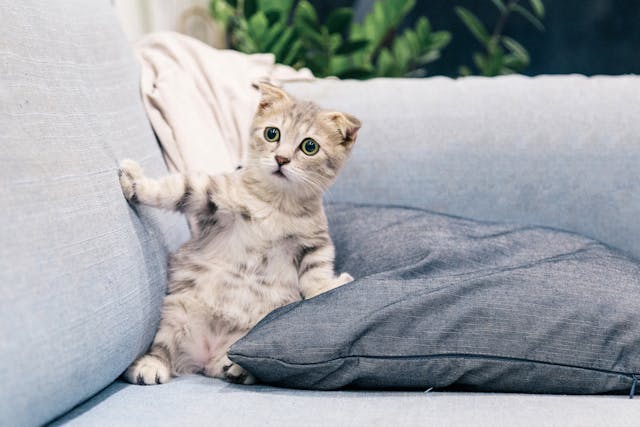Cat Scratching Couch and Chair: The Ultimate Guide to Preventing Damage
Introduction
If you’re a cat owner, you’re probably familiar with the behavior of cat scratching. One of the most common places that cats love to scratch is your couch and chairs. While this behavior is natural for them, it can be incredibly frustrating when they ruin your furniture. Understanding why cats scratch and how to stop it can help preserve your furniture and keep your cat happy. In this article, we will explore the reasons behind a cat scratching couch and chair, effective solutions to deter them, and tips on how to protect your furniture from damage.
Cats scratch to mark their territory, sharpen their claws, and stretch their muscles. It’s instinctual, and no matter how well-behaved your cat is, it’s unlikely to completely stop scratching. The problem arises when they choose to scratch furniture like your couch and chair, which can be costly to repair or replace. Knowing how to prevent or redirect this behavior is essential in maintaining your home and keeping your cat content.
A common misconception is that cats scratch out of spite or to annoy their owners, but this behavior is rooted in their natural instincts. Cats have scent glands in their paws that they use to mark their territory, and scratching helps them stretch their muscles and keep their claws sharp. This is why a cat scratching couch and chair is so frequent; it’s an ideal surface for them to engage in this behavior.
To manage a cat scratching couch and chair, it’s important to provide alternatives, such as scratching posts or pads. Cats need outlets for their scratching urges, and if you provide them with appropriate alternatives, they are more likely to redirect their behavior away from your furniture. Furthermore, training your cat to avoid scratching your couch and chair can take time and patience, but with consistent effort, you can minimize damage and create a more harmonious living space for both you and your pet.
In the following sections, we’ll discuss the reasons why cats scratch, how to stop the behavior, and preventive measures you can take to protect your furniture. By understanding your cat’s instincts and providing the right tools, you can find a solution that works for both your cat and your furniture. Let’s dive in!
Why Do Cats Scratch Furniture?
The Natural Instinct Behind Scratching
When you notice your cat scratching the couch and chair, it may feel like they are simply being mischievous, but the reality is that scratching is an innate behavior for cats. It helps them in several ways:
Territorial Marking: Cats have scent glands in their paws, and by scratching, they leave behind their scent as a marker. This signals to other animals that this area is claimed as their territory.
Sharpening Claws: Scratching helps cats remove the outer layer of their claws, keeping them sharp and functional. It’s also a way for cats to maintain the health of their claws.
Stretching Muscles: Scratching provides a good stretch for cats, especially for their back and shoulder muscles. This is important for their overall health and flexibility.
Understanding these natural reasons for scratching can help you approach the situation with empathy and a strategy to minimize damage. Although a cat scratching couch and chair is frustrating, it’s part of your cat’s natural behavior that should be redirected rather than punished.
What Makes Couches and Chairs So Attractive to Cats?
Couches and chairs are typically made from soft yet durable materials, which makes them ideal for scratching. Cats tend to go for textured surfaces like fabric, leather, and upholstery because it provides a good balance between resistance and softness, allowing them to get a good stretch and achieve their scratching goal.
In addition, furniture is often in areas where cats spend a lot of time. This includes living rooms, which are high-traffic areas, and places where cats like to hang out with their owners. It’s easy for them to see your couch or chair as the perfect scratching spot because it’s accessible and provides everything they need.
How to Prevent Your Cat from Scratching the Couch and Chair
Providing Scratching Alternatives
One of the most effective ways to prevent your cat from scratching the couch and chair is to offer alternatives. Scratching posts are the most popular choice, but you can also provide scratching pads, carpeted ramps, or even cardboard scratchers. Choose a scratching surface that appeals to your cat’s preferences—some cats prefer vertical posts, while others may enjoy horizontal pads.
It’s important to place these alternatives near the areas where your cat typically scratches. If they love scratching the back of your couch, try putting a scratching post next to it. Over time, your cat will likely begin using the scratching post instead of the furniture.
Using Deterrents
Deterrents are another useful tool for preventing a cat scratching couch and chair. There are several commercially available sprays designed to deter cats from scratching. These sprays often have unpleasant scents like citrus or lavender, which cats dislike. Another option is to use double-sided tape on the areas of the couch and chair where your cat scratches. Cats dislike the sticky feeling, and it may help deter them from scratching.
If you want to go the extra mile, you can also use furniture protectors. These are adhesive strips that cover the areas where your cat scratches the most. They are discreet and can effectively protect your furniture while also discouraging scratching.
Regular Nail Trimming
Keeping your cat’s claws trimmed is another essential part of managing a cat scratching couch and chair. While trimming won’t stop the scratching behavior entirely, it can help reduce the damage done to your furniture. When trimming your cat’s claws, be sure to only cut the sharp tips and avoid cutting too close to the sensitive quick inside the claws.
If you’re unsure how to trim your cat’s claws, consult a veterinarian or a pet groomer for advice on the best method. Keeping your cat’s claws at a manageable length can significantly reduce the amount of damage caused by scratching.
Training Your Cat to Avoid Scratching
Training your cat to avoid scratching the couch and chair requires patience and consistency. Whenever your cat starts to scratch furniture, gently redirect them to their scratching post or pad. Reward them with praise or treats when they use the appropriate scratching surface. Over time, they’ll learn that scratching the post is the best way to fulfill their natural urges.
It’s also important to remain calm and avoid punishing your cat. Cats don’t respond well to punishment, and it can lead to confusion or fear. Instead, focus on positive reinforcement and redirection.
Protecting Your Furniture
Furniture Covers and Slipcovers
Investing in furniture covers or slipcovers is a practical way to protect your couch and chairs from scratches. These covers can be easily removed and washed, which helps keep your furniture looking new even if your cat continues to scratch.
Look for covers made from durable, scratch-resistant materials like heavy-duty fabrics or leather. While these may not completely stop your cat from scratching, they can provide an added layer of protection.
Reupholstering Furniture
If your furniture has already sustained damage from scratching, reupholstering might be a good solution. Professional reupholstery can help repair your couch and chair, making them look as good as new. This is an investment that can extend the lifespan of your furniture while still accommodating your cat’s natural instincts.
Training Your Cat Early
If you have a kitten, start training them to use scratching posts early on. Introducing them to appropriate scratching surfaces at a young age will help set them up for good behavior throughout their life. If you wait until your cat is older, it may be more difficult to change established habits.
FAQ Section
Q: Why does my cat scratch my couch and chair?
A: Cats scratch furniture to mark their territory, sharpen their claws, and stretch their muscles. It’s a natural and instinctual behavior.
Q: How can I stop my cat from scratching my furniture?
A: Providing scratching alternatives like posts, using deterrents, regularly trimming your cat’s claws, and training them to use the proper surfaces can help stop scratching.
Q: Is it safe to use sprays to deter scratching?
A: Yes, sprays specifically designed for this purpose are safe when used as directed. However, avoid using harsh chemicals that could harm your cat.
Q: How often should I trim my cat’s claws?
A: You should trim your cat’s claws every 2-4 weeks, depending on how fast they grow.
Conclusion
Dealing with a cat scratching couch and chair can be frustrating, but with patience and the right approach, you can protect your furniture and maintain a healthy relationship with your cat. Remember that scratching is a natural instinct, and providing alternatives, using deterrents, and practicing positive reinforcement can help manage the behavior. With these strategies in place, you can preserve your furniture and create an environment where both you and your cat are happy.

Share this:
- Click to share on Facebook (Opens in new window) Facebook
- Click to share on X (Opens in new window) X
- Click to share on LinkedIn (Opens in new window) LinkedIn
- Click to share on Reddit (Opens in new window) Reddit
- Click to share on X (Opens in new window) X
- Click to share on Threads (Opens in new window) Threads
- Click to share on WhatsApp (Opens in new window) WhatsApp




